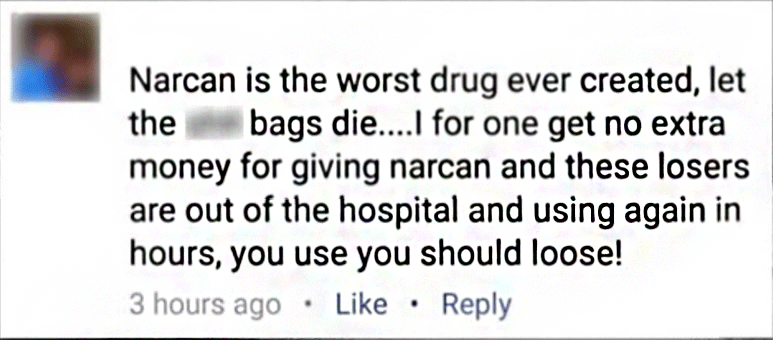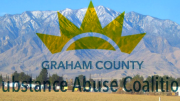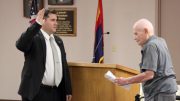By Brooke Curley
SAFFORD – A wife, husband, brother, sister, mother, father or friend lies dying. Breath has left the body, the face turns pale blue. With only a matter of minutes between life and death, a life-saving drug – one that blocks the opiates that are killing human beings in the Gila Valley and nationwide – is now as easily administered as nasal spray.
Available to the general public at local pharmacies by the beginning of April, the nasal spray Narcan and injectable Naloxone opioid antidotes could change the face of addiction in the Gila Valley.
Graham County Substance Abuse Coalition Coordinator Kathy Grimes told Gila Valley Central that recently an antidote training was provided by Sonoran Prevention Works. The classes aimed to educate the police, medical staff and the general public.
“My understanding is within the next month our pharmacy board is making it where it will be available for individuals to buy it over the counter,” Grimes said.
The nasal spray, Narcan, will be given to police personnel. The nasal spray version of Narcan is more expensive than the injectable Naloxone form, but it is also easier for the general public to use by just spraying the opioid antidote up the victim’s nose rather than having to inject them with it.
Critics of the antidotes argue that bringing a safety net into the delicate situation of drug addiction might tip the scales toward the negative, creating more committed addicts. However, Grimes said this idea is a misconception.

Source: www.newbedfordguide.com: This was posted by a Weymouth Mass. firefighter who was suspended for 90 days because of this Facebook comment regarding Narcan.
“A lot of people believe that if you have the Narcan on hand it would just encourage people to just use the opioids because that’s there,” Grimes said. “It’s not something that people would say, ‘No I can get as high as I want because my family member has the Narcan and they can save me.’ It’s not that at all. The Narcan makes you very sick, but it does save people’s lives.”
Grimes added that the effects of the opioid antidote are very uncomfortable for the victim. Although Narcan may save the victim’s life, it will instantly throw the individual into all of the painful sensations of withdrawal.
“Oftentimes, they vomit and they diarrhea, and lots of different things happen because they’re going through the withdrawals,” Grimes said. “It takes the opioids away from the brain receptors and replaces it with the Narcan. And that makes people very sick.”
Chris Taylor, Safford City Councilor and executive director of Desert Eagle Addiction Recovery, said he believes the antidote to be a very useful tool in fighting the disease of drug addiction. By saving an individual on the brink of death via overdose, Taylor trusts that there will be more individuals interested in recovery.
“I can’t count how many people I personally know or have heard of that decided to completely turn their lives around after a near fatal overdose,” Taylor said. “For many people, that is the wake-up call they needed to finally allow themselves to be helped.”
When asked what he thought about the possibility individuals may see the antidotes as more of an enabling device than a tool for recovery, Taylor said that idea doesn’t hold water.
“On the one hand, I see why people might think this will be the case, but I can tell you that it is a very flawed way of thinking,” he said. “When someone is in the throes of addiction, they aren’t thinking the same way a rational person thinks. The only thing that their brain in its altered state allows them to think is, ‘I need to get more drugs at all cost in order to stave off the intense sickness of withdrawal.’ I can tell you that nobody is thinking, ‘I can use more heroin now even if it kills me because I can just be brought back from the dead.’ It doesn’t work that way, and frankly, who are we to make that judgment? A life is a life. I don’t know how some people can be so callous and careless when it comes to human life.”
How to Administer Intranasal Naloxone
- Lie your friend on their back.
- Peel the silver backing off of the Narcan package.
- Do not test the device. Once you push the plunger, it all comes out at once and you will not be able to spray any more.
- Stick the tip of the device into your friend’s nostril and push the plunger, expelling all of the medication.
- While you’re waiting for it to kick in, perform rescue breathing on the person. No need for chest compressions, just tilt their head back, plug their nose, and give a deep breath every 5 seconds.
- If the first dose doesn’t wake your friend up within 2 minutes, give them the second dose.
- Rescue breathe for them until they can breathe on their own.
- Once they’re breathing on their own, place them on their side with their hand under their head.
How to Administer Intramuscular Naloxone
If you suspect an opiate overdose, rub the person’s sternum hard with your knuckles. If they do not respond to the pain, call 911 and then give the person naloxone.
- Pop the orange lid off of one vial. Stick an intramuscular 1 needle into the thin film & pull up all of the liquid. If you don’t have an intramuscular needle, you can use an insulin syringe, though it is not ideal.
- Stick the needle in the victim’s arm or thigh and inject all of the medication. No need to look for a vein.
- While you’re waiting for it to kick in, perform rescue breathing on the person. No need for chest compressions, just tilt their head back, plug their nose, and give a deep breath every 5 seconds.
- If the first dose doesn’t wake your friend up within 2 minutes, give them the second dose. Use a new syringe.
- Continue to rescue breathe for them until they can breathe on their own.
- Once they’re breathing on their own, place them on their side with their hand under their head.
Source: http://spwaz.org/overdose-prevention/













.jpg)